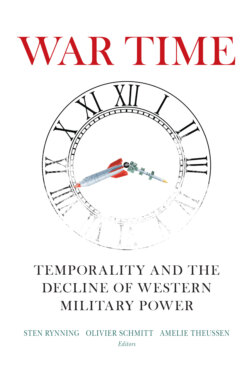Читать книгу War Time - Группа авторов - Страница 20
На сайте Литреса книга снята с продажи.
Conclusion
ОглавлениеAs this historical analysis has shown, it was financing that not only set the West apart from the rest, but also resulted in large-scale, deadlier, if more efficient wars. By the time of the modern era, states in the West could raise more money and armies than states elsewhere. It is telling that the Japanese—who were humiliated by Commodore Perry’s forceful dismantling of their isolationist policy of Sakoku—were able to defeat Russia by 1905 after adopting “Western” types of war finance. Yet we also know that it is financing that allows for states to sustain (if barely) large-scale armies. As Parker writes of the enormous wealth of Amsterdam coupled with the good credit of the United Provinces in the seventeenth century, “This combination enabled the Dutch to raise an army and go on fighting, whatever the cost, until they got their own way.”44 Financing, then, is an integral part of determining the length and magnitude of certain wars. It affects the type of wars that countries fight, the way they fight them, and the speed and decisiveness with which they are able to do so.
A second major implication of this analysis is that the turn to extraction, even if largely an aberration rather than the norm, did have the restraining effect of linking government decisions and the costs of war to society’s probing. The decline of extraction has produced a decline in the public investment and scrutiny that helped create a check both on the wars the United States and others opted to wage and on the determination with which they fought. It is not surprising that the recent wars in Afghanistan and Iraq, where extraction was consciously shunned, have been the longest in American history. Without the constant reminders that come from fiscal sacrifice, the public is increasingly disconnected from wars, imposing few pressures on leaders to bring them to a rapid and decisive end.
Third, and more generally, the history of war finance offers insights about the arc of civic militarism in the West. Hanson has suggested its continuity from ancient Greece to the present, emphasizing the sense of societal cohesion and liberal notion of “free men fighting wars by consensus” as aspects of Western society. The history of extraction suggests that states in the West may look like sleeping giants: technological barriers to extraction have been largely removed; but leaders cannot whip up the sentiment for sacrifice among the public. Indeed, as Sarah Kreps argues, we may have hit an upper limit in terms of citizens’ willingness to sacrifice their own incomes to pay for (war) taxes.45
Yet at the same time, through the mechanism of debt financing, states have been able to circumvent democratic accountability for militarized foreign policy strategies. What results is a paradox. The Western state is powerful in theory, capable of raising enormous revenues to fight and win decisively, but it is weak in practice, unable to galvanize the public to accept higher levels of extraction in return for either additional rights or the simple yet essential public good of state security. Instead, leaders have sought to reduce the visible costs of war, circumvent limits on mobilization, and loosen decision-making constraints. If this analysis is any indication, the recent past of long, open-ended, yet less lethal wars is therefore likely to be a prologue, foreshadowing the distinct likelihood of future, prolonged war.
